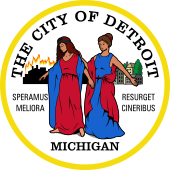Regional Transit Authority of Southeast Michigan
| Overview | |
|---|---|
| Locale | Metro Detroit |
| Transit type | bus, bus rapid transit (future) |
| Headquarters | Detroit, Michigan |
| Website | http://www.rtamichigan.org/index.html |
| Operation | |
| Began operation | 2013 |
The Regional Transit Authority of Southeast Michigan (RTA) is the agency with oversight and service coordination responsibility for mass transit operations in metropolitan Detroit, Michigan. The counties of Macomb, Oakland, Washtenaw, and Wayne are included in the agency's jurisdiction.[1]
Overview
The RTA is governed by a 10-member board which includes two representatives from each county, one representative from Detroit, and one non-voting representative appointed by the governor who chairs the board.[1] The board hires a CEO to oversee the day-to-day operations of the authority.
Powers
The board is granted the authority with a 7/9 supermajority of the voting members the powers to:[2]
- determine the rate of and place on the ballot a levy of an assessment for the funding of transit services and operations.
- determine the rate of and place on the ballot a vehicle registration tax for the funding of tranist services and operations.
- determine to acquire existing street railways and acquire, construct or operate planned commuter rail services in the region.
The board is granted the authority with unanimous consent the powers to:
- determine to acquire a public transit provider in the region.
- place on the ballot a question of assuming liability or paying legacy costs of an acquired public transportation provider.
History
The RTA has its beginnings in the Metropolitan Transportation Authorities Act of 1967 (Public Act 204).[3] A provision of the act specifically created the Southeastern Michigan Transportation Authority (SEMTA), but provided the authority with no additional means to levy taxes or fees to fund the operations for the transit providers it had acquired.
In 1974, facing a loss of funding from SEMTA and wanting more control of its transit affairs, Detroit's Department of Street Railways (DSR) restructured itself as the Detroit Department of Transportation (DDOT).[4] On December 7, 1988, Public Act 204 was amended to restructure SEMTA, reducing the service area from seven counties to three, and excluding the city of Detroit.[4] The new transit authority was named the Suburban Mobility Authority for Regional Transit (SMART), and began operation on January 17, 1989. To continue limited coordination and development of services between DDOT and SMART, however, regional leaders representing the three-county area and Detroit filed articles of incorporation to form the Regional Transit Coordinating Council on January 12, 1989.[4]
On December 19, 2012 Governor Rick Snyder signed Senate Bill No. 909 into law establishing the Regional Transit Authority (RTA), which included a provision allowing for the first time a way for such a regional transit authority to fund itself.[5] Almost one month later, US Transportation Secretary Ray LaHood announced that the M-1 Rail Line would receive 25 million in federal funding as he had previously indicated such support was dependent on the creation of a regional transit authority for the Detroit region.[6]
Along with oversight and coordination responsibilities for the Detroit Department of Transportation, Suburban Mobility Authority for Regional Transportation, Ann Arbor Area Transportation Authority, and the Detroit Transportation Corporation, the authority was also established to create a single mass transit plan for the region, including the development, funding and operation of rapid transit along four major corridors in the metropolitan area. The new plan used as its basis the Comprehensive Regional Transit Service Plan, which was adopted on December 8, 2008.[7] The RTA chose HNTB to assist in the development of the Regional Master Transit Plan in 2015.
Future services
In early 2015, the RTA retained Parsons Brinkerhoff and AECOM to study improved mass transit along the corridors of Gratiot and Michigan avenues. The authority also took over oversight of the Woodward Avenue Alternative Analysis Rapid Transit Alternative study,[8] which found BRT (bus rapid tranist) as the locally preferred alternative as the improved mode of transit along a 27-mile stretch of Woodward Avenue.[9] The RTA announced on April 7, 2015 that it was seeking a request for proposal for express bus service to Detroit Wayne County Metropolitan Airport as a demonstration project.[10]
See also
Transportation in metropolitan Detroit
References
- 1 2 "Regional Transit Authority". SEMCOG.
- ↑ "Public Act No. 246". legislature.mi.gov. State of Michigan. Retrieved 13 February 2015.
- ↑ "Metropolitan Transportation Authorities Act of 1967". Michigan Legislature. Retrieved 12 January 2014.
- 1 2 3 "History of Transit in Southeast Michigan Region". SMART Overiew. SMART. Retrieved 12 January 2014.
- ↑ "Senate Bill No. 909" (PDF). State of Michigan 96th Legislature. Retrieved 17 September 2013.
- ↑ "M1 Rail: Ray LaHood, U.S. Transit Secretary, Announces $25 Million In Funding For Detroit Transit Plan". HuffPost Detroit. January 18, 2013. Retrieved 27 January 2016.
- ↑ "Comprehensive Regional Transit Service Plan". SEMCOG.org. Retrieved 12 January 2014.
- ↑ "Woodward Avenue Rapid Transit Alternatives Analysis Locally Preferred Alternative" (PDF). Parsons Brinckerhoff. Retrieved 19 April 2015.
- ↑ "Woodward Avenue Rapid Transit Alternative Analysis". SEMCOG. Retrieved 19 April 2015.
- ↑ AlHajal, Khalil (7 April 2015). "Transit authority to pursue express bus service to Detroit Metro Airport". MLive.com (Booth News). Retrieved 19 April 2015.
External links
| |||||||||||||
| |||||||||||||||||||||||||||||||||||||||||

